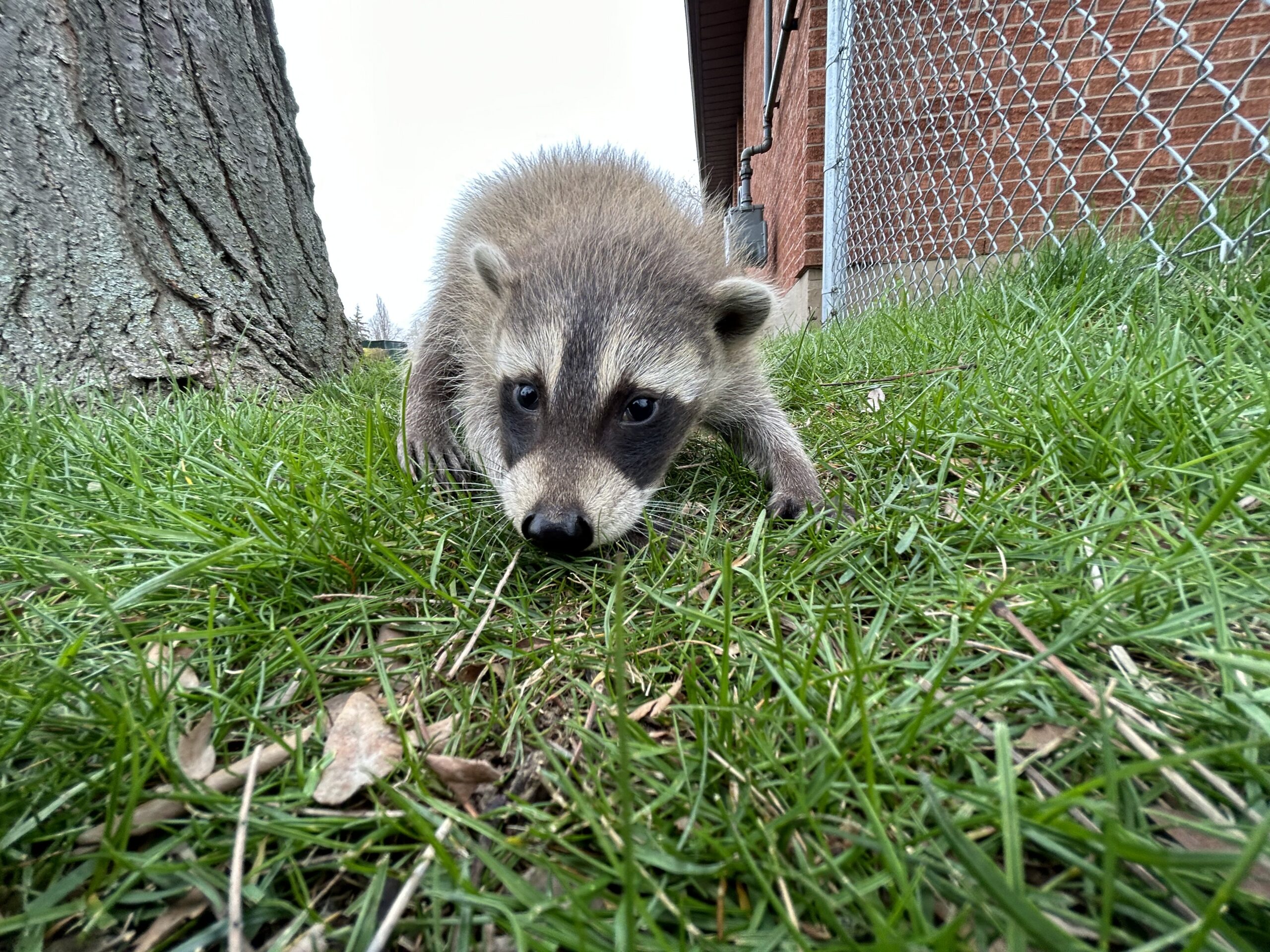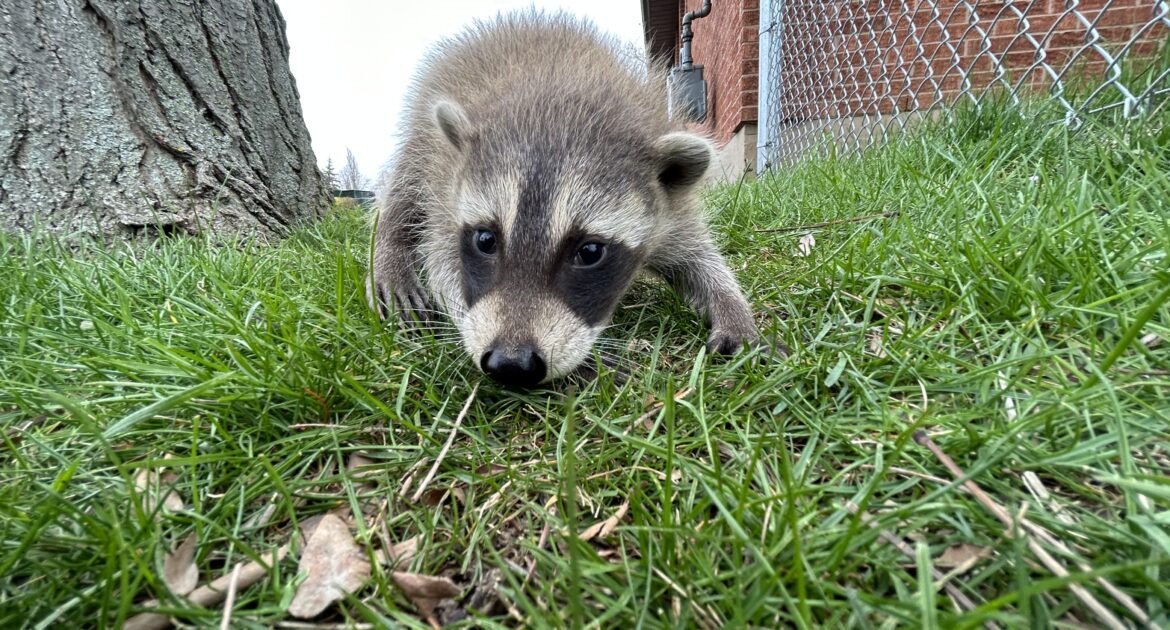Do you frequently hear strange noises coming from your backyard at night? Chances are, you might have some uninvited guests scurrying around and causing problems. Raccoons are some of the most common wildlife that invade residential areas, especially in Edgewater. But what is attracting them to your yard?
Raccoons are attracted to your property for various reasons, including the availability of water, hiding spots, and food. The question is, how do you get rid of them and deter them from coming into your home?
Our experts at Skedaddle have decades of experience in dealing with wildlife and understanding their habits. We know the precise strategies to deter raccoons from entering your yard and keep them out of your home. Our raccoon removal in Edgewater can not only keep your property clear of wildlife, but also keep your family safe.
Understanding raccoon behavior and what attracts them to your yard is the first step in keeping them out. So join us as we take a look at why these creatures may be sniffing around your yard!
Understanding The Habits Of Your Nighttime Visitors
Before diving into what is attracting raccoons to your yard, let’s take a quick look at their habits to better understand the species. Contrary to what many might think, these nighttime fellows have quite fascinating behaviors. They are nocturnal animals, most active during the night. Understanding these behaviors can be very helpful in removing them from your yard.
They Are Excellent Climbers
Raccoons are incredible climbers. That means your trees, fences, and even your home can easily become a device for exploration for these agile beings. Cutting overhanging branches and making sure your fences are smooth and challenging to climb can deter them.
Excellent Climbing Ability
Raccoons possess an exceptional ability when it comes to climbing, making them adept at navigating various vertical surfaces with ease. This innate skill allows them to view trees, fences, and even the structures of your home not just as parts of your landscape, but as opportunities for exploration and adventure. Their agility and nimbleness mean that they can effortlessly scale these structures, potentially leading to unexpected visits or encounters.
Dexterous Foragers
Raccoons are equipped with remarkably dexterous hands that possess the finesse and agility to perform a variety of tasks, which, while fascinating from a biological standpoint, can lead to several challenges for homeowners. These nimble appendages are so adept that they enable raccoons to easily manipulate objects in their environment, much like humans do with their own hands. This unique trait allows them to engage in behaviors that, although natural to them, can become quite troublesome from a human perspective.
One of the most common manifestations of this dexterity is observed in their ability to open trash cans. Raccoons can easily remove lids or even unlock clasps, turning our garbage into a veritable feast for them. This not only creates a mess that homeowners have to clean up but also encourages raccoons to return, knowing that food is readily available.
Beyond scavenging through trash, raccoons’ manual dexterity extends to more delicate activities, such as digging up gardens or flower beds. Their hands allow them to expertly grub up the soil, searching for worms or other edible morsels. This behavior can wreak havoc on your carefully tended garden or destroy your favorite flower beds, leading to frustration and the potential loss of many hours of hard work and care invested in cultivating these spaces.
Perhaps one of raccoons’ most surprising abilities is their ability to untie shoelaces. This might seem amusing at first glance, but it’s a testament to the precision with which raccoons can manipulate objects. While the chance of a raccoon untying someone’s shoelaces is relatively rare, it underscores the level of skill and adaptability these creatures have developed to interact with their environment, including items produced by humans.
Raccoons Are Omnivores
Many individuals may be unaware that raccoons possess a highly versatile and omnivorous diet, meaning they can consume both plant- and animal-based foods. This dietary flexibility allows them to adapt to a wide range of environments and food sources, making them one of the more resourceful creatures in the animal kingdom. Raccoons’ diet is incredibly diverse, encompassing a broad spectrum of foods that can vary based on their habitat, the season, and what is readily available to them.
When it comes to plant-based foods, raccoons are known to enjoy a variety of fruits and vegetables. Depending on what they can find in their environment, they might feast on berries, apples, acorns, and corn. These foods provide them with essential nutrients and energy to support their active lifestyles. Vegetables found in gardens or wild plants in their natural habitats can also form a significant part of their diet, illustrating their ability to exploit both natural and human-modified environments for sustenance.
On the animal-based side of their diet, raccoons are equally opportunistic. They consume insects such as beetles and worms, which are abundant and easy to catch. Eggs are another favorite, whether sourced from birds’ nests or even turtle nests, providing a rich source of protein. Raccoons will also prey on poultry if the opportunity arises, showcasing their adaptability and sometimes bringing them into conflict with humans, especially those raising chickens or other small livestock.
A raccoon’s diet can also include small mammals, fish, and crustaceans. Their ability to catch fish or crabs, especially in regions near water bodies, adds another dimension to their dietary habits. This not only demonstrates their skill and versatility but also their importance in maintaining ecological balance by controlling populations of various species.
They Prefer Living in Safe and Comfortable Dens
Raccoons are highly adaptable creatures that prioritize finding habitats, offering them safety, comfort, and proximity to food sources. Their ability to thrive in a variety of environments is remarkable, ranging from dense forests to urban areas. Among their preferred dwellings are hollow trees, which provide natural shelters that offer protection from predators and harsh weather conditions. These natural cavities offer an ideal environment for raccoons to rest during the day and raise their young in relative safety.
The adaptability of raccoons in finding and creating comfortable living spaces is a testament to their survival skills. Whether it’s the natural cavity of a tree in a forested area or the man-made confines of an attic or under a deck, raccoons prioritize locations that provide them with the security and comfort necessary for their well-being. This versatility in habitat selection allows raccoons to coexist with humans, albeit sometimes leading to conflicts, particularly when they encroach on human dwellings in search of a safe haven.
A comprehensive understanding of these habits can not only aid in deterring these uninvited guests but also in developing a respectful and sympathetic outlook. After all, they are just trying to find food and shelter like any other creature.
What Attracts Raccoons To Your Yard?
Understanding what draws these nocturnal visitors to your yard is key to making the space less attractive. Let’s take a look at what may be in your yard that is attracting raccoons and making it an inviting space to them.
Water Source
The presence of stagnant water or even a modest-sized pond within the confines of your garden can unexpectedly transform into an ideal oasis for various wildlife, particularly raccoons. These resourceful creatures are constantly in search of reliable sources of water to satisfy their fundamental needs, primarily for hydration. However, their relationship with water extends beyond merely quenching their thirst. Raccoons also engage in a unique and somewhat intriguing behavior known as ‘dousing,’ where they appear to wash their food before consumption.
In essence, any body of water in your garden, regardless of size, can fulfill multiple essential raccoon needs. It offers them a steady supply of water for drinking, a place for performing their unique food-washing rituals, and, potentially, a peaceful refuge that mimics the natural habitats from which they originate. While this may foster an opportunity for closer observation and appreciation of these fascinating creatures, it also underscores the importance of managing such water sources responsibly to ensure that the coexistence between humans and wildlife remains harmonious and conflict-free.
Safe Shelter
In more urbanized areas, raccoons have shown an incredible ability to adjust to human environments, seeking out alternative shelters that mimic the safety of their natural habitats. Attics, for instance, have become a popular choice for these resourceful animals. An attic’s secluded and warm environment mimics the secure feeling of a hollow tree, making it an attractive option for raccoons looking for a safe place to nest and rear their offspring. Homeowners may find themselves unwitting hosts to raccoon families, as these animals can exploit small openings to gain access to these cozy, undisturbed spaces.
Similarly, the undersides of decks provide another appealing shelter for raccoons in suburban and urban settings. These areas often offer the seclusion and protection raccoons seek, away from the prying eyes of predators and humans alike. The space beneath a deck can resemble the enclosed, safe environment of a hollow log or tree base, making it an ideal spot for raccoons to take refuge, especially during the daytime or when rearing young.
Easy Access to Food
Unlike many other wildlife species that have strict dietary preferences, raccoons exhibit a remarkable lack of fussiness when it comes to their diet. This omnivorous nature allows them to thrive in a variety of settings, particularly in urban areas where human activity provides an abundance of potential food sources.
Unsecured garbage bins are a prime example of how human habitats inadvertently cater to the raccoon’s dietary needs. These animals possess a keen sense of smell and are adept at manipulating objects with their dexterous paws, making it relatively easy for them to access the contents of trash cans. Leftover food, discarded scraps, and even non-food items that might attract insects serve as a buffet for these curious creatures, offering them a diverse menu to choose from each night.
Additionally, pet food that is left outside can become an unintended yet highly attractive meal for raccoons. Many pet owners may not realize that the food they leave out for their cats or dogs can also feed local wildlife. With their adaptable palates, Raccoons will not hesitate to consume pet food, which is often rich in nutrients and requires no effort to procure compared to foraging in the wild.
The presence of fruit trees in urban and suburban gardens also provides another source of sustenance for raccoons. Fallen fruit is an easy target for these animals, who are always on the lookout for the least energy-intensive food sources. Whether it’s apples, berries, or other types of fruit, raccoons will gladly take advantage of these offerings, further supplementing their varied diet.
Quiet and Rarely Disturbed Areas
Our masked nocturnal visitors cherish peace and quiet, hardly ever intruding into areas of the home that are frequently disturbed. Whether it’s an abandoned corner of a basement, an attic filled with old furniture, or a patch under the deck where no human tread disturbs. These secretive creatures are always on the lookout for concealed and undisturbed places to establish their domain.
Now that we know what attracts these nocturnal wanderers to our yards, the next step is to take preventative action. By managing these attractions, we can gently and ethically encourage these intriguing yet unwelcome guests to move on in search of new habitats.
Take Action: Steps to Make Your Yard Unappealing to Raccoons
Implementing certain measures can help discourage visits from our furry intruders. Here at Skedaddle, we have decades of experience and can suggest some effective ways to make your yard less appealing to them.
Secure Your Trash – Securing your trash cans is one of the most effective steps you can take to discourage these foragers from your yard. You can do this by investing in raccoon-resistant trash cans or by securing the lids with a sturdy strap or a weight.
Remove Potential Denning Sites – As previously mentioned, these wild neighbors often take shelter in structures such as hollow trees, sheds, or under decks. By sealing off these areas, you can significantly reduce the chances of these creatures considering your property as a suitable habitat.
Maintain a Clean Yard – Keeping your yard clean and well-maintained not only enhances its aesthetic appeal, but can also help to reduce the availability of potential food sources – falling fruits or leftover pet foods, for instance. Also, clear away any water sources that may attract them.
Install Lighting – Remember, these night explorers are nocturnal. Installing motion-activated lights can be an effective deterrent as they prefer to work in the dark.
Trim Branches – Trim any branches that hang too close to your home, as these can provide easy access points for raccoons looking to explore higher ground or find entryways into attics or roof spaces. By cutting back these overhanging limbs, you reduce the likelihood of raccoons using them as bridges to your home.
By securing your property, you can help prevent raccoons from seeing your outdoor spaces as attractive areas for exploration. While raccoons are naturally explorative and agile creatures, implementing these strategies can make your home less inviting to them, protecting both your property and the local wildlife by encouraging raccoons to remain in their natural habitats.
All these strategies, however, should be implemented with the understanding that these creatures are simply trying to survive. At Skedaddle, we passionately believe in humane and ethical wildlife control. We can help you deter your unwelcome guests without causing them any harm.
When to Call Skedaddle for Raccoon Removal in Edgewater
There may be instances, despite your DIY raccoon deterrent efforts, where the help of a professional is required. So when should you contact us?

Consistent Evidence of Activity
You’ve taken steps to dissuade our masked visitors, but you’re still noticing signs of their activity. This might be in the form of overturned trash cans, raided gardens, damaged bird feeders, or nocturnal noises from your attic or crawlspace. Recognizing these signs is pivotal for timely intervention.
Visible Damage to Your Home or Property
Though you may not always see these nighttime wanderers, one clear sign of their presence is damage to your home or property. From torn vents and soffits to damaged lawns and gardens, these are not just unsightly but can also lead to more significant structural problems if not addressed promptly.
Recognizing the Risks
Remember, these animals can carry a host of diseases and parasites. In addition, they have been known to fiercely protect their dens, posing a risk to pets and potentially even humans. Make sure to give us a call if you have any concerns about possible health risks.
Equipped with a well-trained team, we utilize specialized techniques that ensure the animals are removed safely and humanely without causing additional harm to them or your property. You can trust us to provide a complete solution that includes clearing, cleaning, and repairing any damage caused, as well as implementing measures to prevent future unwanted visits.
Knowing when to call a professional is important. Reach out to us at Skedaddle Humane Wildlife Control in Edgewater, Maryland for comprehensive solutions to keep your yard and home free of raccoons. You don’t have to do it alone. Skedaddle is your trusted partner in humane raccoon removal.




